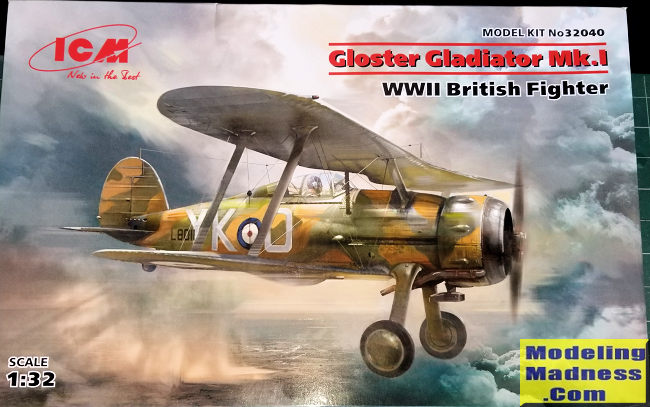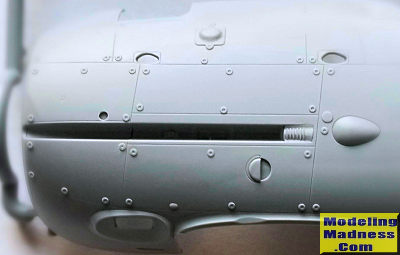
ICM 1/32 Gloster Gladiator
| KIT #: | 32040 |
| PRICE: | $65.00 |
| DECALS: | Four options |
| REVIEWER: | John Summerford |
| NOTES: | No seat harness |

| HISTORY |
The Gloster Gladiator (or Gloster SS.37) was a British-built biplane fighter. It was used by the Royal Air Force (RAF) and the Fleet Air Arm (FAA) (as the Sea Gladiator variant) and was exported to a number of other air forces during the late 1930s. It was the RAF's last biplane fighter aircraft and was rendered obsolete by newer monoplane designs even as it was being introduced. Though often pitted against more formidable foes during the early days of the Second World War, it acquitted itself reasonably well in combat.
The Gladiator saw action in almost all theatres during the Second World War, with a large number of air forces, some of them on the Axis side. The RAF used it in France, Norway, Greece, the defense of Malta, the Middle East, and the brief Anglo-Iraqi War (during which the Royal Iraqi Air Force was similarly equipped). Other countries deploying the Gladiator included China against Japan, beginning in 1938; Finland (along with Swedish volunteers) against the Soviet Union in the Winter War and the Continuation War; Sweden as a neutral non-combatant (although Swedish volunteers fought for Finland against USSR as stated above); and Norway, Belgium, and Greece resisting Axis invasion of their respective lands.
The South African pilot Marmaduke "Pat" Pattle was the top Gladiator ace with 15 victories with the type.
[Perhaps the most famous Gladiator story is the siege of Malta]
A stock of 18 Sea Gladiators from 802 Naval Air Squadron had been delivered by HMS Glorious, in early 1940. Three were later shipped out to take part in the Norwegian Campaign and another three were sent to Egypt. By April, Malta was in need of fighter protection and it was decided to form a flight of Gladiators at RAF Hal Far, to be composed of RAF and FAA personnel. Several Sea Gladiators were assembled and test-flown. In the siege of Malta in 1940, for ten days the fighter force defending Malta was the Hal Far Fighter Flight, giving rise to a myth that three aircraft, named Faith, Hope and Charity, formed the entire fighter cover of the island. The aircraft names came into use after the battle. More than three aircraft were operational, though not always at the same time; others were used for spare parts. No 1435 Flight, which later assumed control of Malta's air defense, took on the names Faith, Hope and Charity for its aircraft upon its reformation as the air defense unit in the Falkland Islands in 1988.
The Italian air force units deployed against Malta should have easily defeated the Gladiators but its maneuverability and good tactics won several engagements, often starting with a dive on Savoia-Marchetti SM.79 Sparviero bombers before the Fiat CR.42 and Macchi MC.200 escort fighters could react. On 11 June 1940, a Gladiator damaged a Macchi and on 23 June, a Gladiator flown by George Burges, managed to shoot down an MC.200. Another successful pilot over Malta was "Timber" Woods who managed to shoot down two S.79s and two CR.42s, also claiming a Macchi hit on 11 June and another S.79 damaged. The Gladiators forced Italian fighters to escort bombers and reconnaissance aircraft. Although the Regia Aeronautica had started with a numerical advantage and air superiority, during the summer of 1940, the situation was reversed with Hurricanes being delivered as fast as possible and gradually taking over the island's air defense.
By June, two of the Gladiators had crashed and two more were assembled. Charity was shot down on 31 July 1940. Its pilot, Flying Officer Peter Hartley, scrambled at 09.45 with fellow pilots F. F. Taylor and Flight Lieutenant "Timber" Woods, to intercept an SM.79, escorted by nine CR.42s from 23° Gruppo. During a dogfight a CR.42 flown by Serg. Manlio Tarantino shot down Hartley's Gladiator (N5519), badly burning him. Woods shot down Antonio Chiodi, commander of the 75a Squadriglia five miles east of Grand Harbor (he was subsequently awarded a posthumous Medaglia d’Oro al Valor Militare, Italy's highest military award). In May 2009, the remains of Charity and others were the subject of an underwater search by NATO minesweepers. Hope (N5531) was destroyed on the ground by enemy bombing in May 1941. The fuselage of Faith is on display at the National War Museum, Fort St Elmo, Valletta today. The fate of at least five more Gladiators that saw action over Malta is not as well documented.
| THE KIT |
 The
flimsy box top encloses another top opening sturdy box. All of the part
sprues are contained in one bag, plus the decals inserted into the
instruction booklet. 130 parts are found on four light gray sprues and one
clear sprue.
The
flimsy box top encloses another top opening sturdy box. All of the part
sprues are contained in one bag, plus the decals inserted into the
instruction booklet. 130 parts are found on four light gray sprues and one
clear sprue.
There are not any photo-etch pieces, so a seat
harness will have to either scratch built or sourced from the aftermarket
folks. Other than th at,
the cockpit is well detailed, including fuselage frame tubing. The
instrument panel has raised detail instead of a decal. There is a choice
between opened or closed canopy. The other choice to make during the build
is the location of radio aerial mast on either the fin, or the rudder,
depending on which decal markings will be used.
at,
the cockpit is well detailed, including fuselage frame tubing. The
instrument panel has raised detail instead of a decal. There is a choice
between opened or closed canopy. The other choice to make during the build
is the location of radio aerial mast on either the fin, or the rudder,
depending on which decal markings will be used.
Four markings are supplied. The first is for a pre-war silver plane with a blue fin. The second is also a pre-war aircraft with a standard dark earth and dark green camouflage pattern topside and white on the underside of the bottom wing and fuselage. The underside of the top wing is silver. The third option is for an aircraft stationed in Egypt during 1940 and painted like the second option
Final decal markings are for the airframe flown
by Pattle while a member of No 80 squadron stationed at Amriy a,
Egypt, in early 1940. It too is painted like the war time aircraft with the
exception that the port underside is painted flat black. This airframe has a
simpler aerial rigging arrangement than the other three.
a,
Egypt, in early 1940. It too is painted like the war time aircraft with the
exception that the port underside is painted flat black. This airframe has a
simpler aerial rigging arrangement than the other three.
A 20-page instruction booklet has a brief description written in Cyrillic and English plus a color call-out chart on the front page. Colors are for Revell and Tamiya paints. The next two pages show the parts map. Building instructions are on the next fourteen pages and comprise 63 steps. The final three pages show the rigging diagrams and painting/decal guides.
| CONCLUSIONS |
Other than the lack of a seat harness, I can’t spot any flaws. The detail is very good. Perhaps the biggest challenge, like most biplanes, is the attaching the struts and getting everything lined up properly. This appears to be a straight forward build.
January 2020
Copyright ModelingMadness.com
If you would like your product reviewed fairly and fairly quickly, please
contact
the editor
or see other details in the
Note to
Contributors. Back to the Main Page
Back to the Review
Index Page
Back to the Previews Index Page